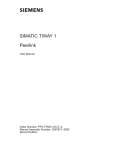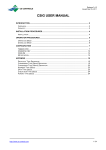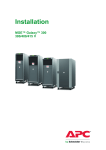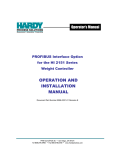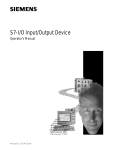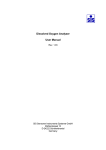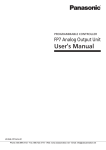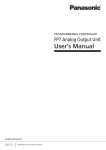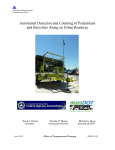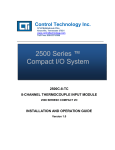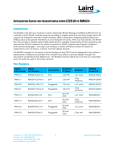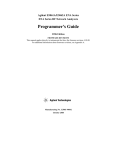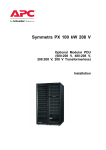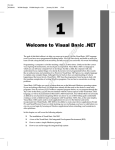Download Siemens High Speed Counter and Encoder Module SIMATIC 505 User's Manual
Transcript
SIMATIC 505 High Speed Counter and Encoder Module User Manual Order Number: PPX:505–8113–2 Manual Assembly Number: 2586546–0019 Second Edition Copyright 1992 by Siemens Industrial Automation, Inc. All Rights Reserved — Printed in USA Reproduction, transmission or use of this document or contents is not permitted without express consent of Siemens Industrial Automation, Inc. All rights, including rights created by patent grant or registration of a utility model or design, are reserved. Since Siemens Industrial Automation, Inc. does not possess full access to data concerning all of the uses and applications of customer’s products, we do not assume responsibility either for customer product design or for any infringements of patents or rights of others which may result from our assistance. 01/21/92 Technical data is subject to change. We check the contents of every manual for accuracy at the time it is approved for printing; however, there may be undetected errors. Any errors found will be corrected in subsequent editions. Any suggestions for improvement are welcomed. Contents Chapter 1 Overview 1.1 Features . . . . . . . . . . . . . . . . . . . . . . . . . . . . . . . . . . . . . . . . . . . . . . . . . . . . . . . . . . 1-2 1.2 Inputs . . . . . . . . . . . . . . . . . . . . . . . . . . . . . . . . . . . . . . . . . . . . . . . . . . . . . . . . . . . . 1–4 1.3 Outputs . . . . . . . . . . . . . . . . . . . . . . . . . . . . . . . . . . . . . . . . . . . . . . . . . . . . . . . . . . . 1–5 1.4 LED Indicators . . . . . . . . . . . . . . . . . . . . . . . . . . . . . . . . . . . . . . . . . . . . . . . . . . . . . 1–6 1.5 Counting Modes . . . . . . . . . . . . . . . . . . . . . . . . . . . . . . . . . . . . . . . . . . . . . . . . . . 1–7 1.5.1 1.5.2 1.5.3 1.5.4 1.5.5 1–7 1–8 1-8 1-9 1-10 Chapter 2 2.1 Pulse-Counter Mode . . . . . . . . . . . . . . . . . . . . . . . . . . . . . . . . . . . . . . . . . . . . . . . . . . Quadrature Mode . . . . . . . . . . . . . . . . . . . . . . . . . . . . . . . . . . . . . . . . . . . . . . . . . . . . 1X Quadrature . . . . . . . . . . . . . . . . . . . . . . . . . . . . . . . . . . . . . . . . . . . . . . . . . . . . . . . 2X Quadrature . . . . . . . . . . . . . . . . . . . . . . . . . . . . . . . . . . . . . . . . . . . . . . . . . . . . . . . 4X Quadrature . . . . . . . . . . . . . . . . . . . . . . . . . . . . . . . . . . . . . . . . . . . . . . . . . . . . . . . Installation Before Installing the Module . . . . . . . . . . . . . . . . . . . . . . . . . . . . . . . . . . . . . . . 2.1.1 2.1.2 2.1.3 2.1.4 2.1.5 2.2 2–2 Visual Inspection . . . . . . . . . . . . . . . . . . . . . . . . . . . . . . . . . . . . . . . . . . . . . . . . . . . . . . Additional References . . . . . . . . . . . . . . . . . . . . . . . . . . . . . . . . . . . . . . . . . . . . . . . . Handling the Module . . . . . . . . . . . . . . . . . . . . . . . . . . . . . . . . . . . . . . . . . . . . . . . . . General Wiring Considerations . . . . . . . . . . . . . . . . . . . . . . . . . . . . . . . . . . . . . . . . Hierarchy of Installation . . . . . . . . . . . . . . . . . . . . . . . . . . . . . . . . . . . . . . . . . . . . . . . 2-2 2-2 2-2 2-3 2-4 Selecting Counter Operation . . . . . . . . . . . . . . . . . . . . . . . . . . . . . . . . . . . . . . 2-5 2.2.1 2.2.2 Selecting Counter Mode . . . . . . . . . . . . . . . . . . . . . . . . . . . . . . . . . . . . . . . . . . . . . . Selecting the Reset Filter . . . . . . . . . . . . . . . . . . . . . . . . . . . . . . . . . . . . . . . . . . . . . . 2-5 2-6 2.3 Inserting the Module in the I/O Base . . . . . . . . . . . . . . . . . . . . . . . . . . . . . . . 2-7 2.4 Wiring the Module . . . . . . . . . . . . . . . . . . . . . . . . . . . . . . . . . . . . . . . . . . . . . . . . . 2-8 2.4.1 2.4.2 2.5 Wiring the Terminal Block . . . . . . . . . . . . . . . . . . . . . . . . . . . . . . . . . . . . . . . . . . . . . . Powering Up the Module . . . . . . . . . . . . . . . . . . . . . . . . . . . . . . . . . . . . . . . . . . . . . . 2-8 2-8 Logging the Module into the Controller . . . . . . . . . . . . . . . . . . . . . . . . . . . . . 2-10 2.5.1 2.5.2 2.5.3 Chapter 3 3.1 Updating the I/O Configuration Definition . . . . . . . . . . . . . . . . . . . . . . . . . . . . . . Selecting the I/O Configuration . . . . . . . . . . . . . . . . . . . . . . . . . . . . . . . . . . . . . . . . Viewing I/O Configuration Chart . . . . . . . . . . . . . . . . . . . . . . . . . . . . . . . . . . . . . . Programming Controller Input Words . . . . . . . . . . . . . . . . . . . . . . . . . . . . . . . . . . . . . . . . . . . . 3.1.1 3.1.2 3.1.3 3.1.4 3.1.5 2-10 2-10 2-11 WX1 (Status Word) . . . . . . . . . . . . . . . . . . . . . . . . . . . . . . . . . . . . . . . . . . . . . . . . . . . . WX2 and WX3 (Channel Count) . . . . . . . . . . . . . . . . . . . . . . . . . . . . . . . . . . . . . . . WY4 (Setup Word) . . . . . . . . . . . . . . . . . . . . . . . . . . . . . . . . . . . . . . . . . . . . . . . . . . . . WY5 – WY8 (Preset Words) . . . . . . . . . . . . . . . . . . . . . . . . . . . . . . . . . . . . . . . . . . . . . I/O Update Consideration . . . . . . . . . . . . . . . . . . . . . . . . . . . . . . . . . . . . . . . . . . . . . 3-2 3-2 3-3 3-3 3-4 3-4 Contents iii Chapter 4 4.1 Checking the Operation of the Module . . . . . . . . . . . . . . . . . . . . . . . . . . . . . Chapter 5 5.1 5-2 5-3 Flow Rate Example . . . . . . . . . . . . . . . . . . . . . . . . . . . . . . . . . . . . . . . . . . . . . . . . 5-5 Description . . . . . . . . . . . . . . . . . . . . . . . . . . . . . . . . . . . . . . . . . . . . . . . . . . . . . . . . . . . Solution . . . . . . . . . . . . . . . . . . . . . . . . . . . . . . . . . . . . . . . . . . . . . . . . . . . . . . . . . . . . . . 5-5 5-5 Tank Filling Example . . . . . . . . . . . . . . . . . . . . . . . . . . . . . . . . . . . . . . . . . . . . . . . 5-6 5.3.1 5.3.2 Appendix A A.1 5-2 Description . . . . . . . . . . . . . . . . . . . . . . . . . . . . . . . . . . . . . . . . . . . . . . . . . . . . . . . . . . . Solution . . . . . . . . . . . . . . . . . . . . . . . . . . . . . . . . . . . . . . . . . . . . . . . . . . . . . . . . . . . . . . 5.2.1 5.2.2 5.3 4-2 Applications Sprayer Example . . . . . . . . . . . . . . . . . . . . . . . . . . . . . . . . . . . . . . . . . . . . . . . . . . 5.1.1 5.1.2 5.2 Troubleshooting Description . . . . . . . . . . . . . . . . . . . . . . . . . . . . . . . . . . . . . . . . . . . . . . . . . . . . . . . . . . . Solution . . . . . . . . . . . . . . . . . . . . . . . . . . . . . . . . . . . . . . . . . . . . . . . . . . . . . . . . . . . . . . 5-6 5-6 Terminal Block Worksheet Terminal Block Worksheet . . . . . . . . . . . . . . . . . . . . . . . . . . . . . . . . . . . . . . . . . A-1 Appendix B Specifications B.1 Environmental Specifications . . . . . . . . . . . . . . . . . . . . . . . . . . . . . . . . . . . . . . B-2 B.2 Electrical Specifications . . . . . . . . . . . . . . . . . . . . . . . . . . . . . . . . . . . . . . . . . . . B-3 B.3 Additional Compliances . . . . . . . . . . . . . . . . . . . . . . . . . . . . . . . . . . . . . . . . . . . B-6 iv Contents List of Figures 1-1 1-2 1-3 1-4 1-5 1-6 1-7 High Speed Counter Module . . . . . . . . . . . . . . . . . . . . . . . . . . . . . . . . . . . . . . 1-3 Output . . . . . . . . . . . . . . . . . . . . . . . . . . . . . . . . . . . . . . . . . . . . . . . . . . . . . . . . . . . 1-5 High Speed Counter LEDs . . . . . . . . . . . . . . . . . . . . . . . . . . . . . . . . . . . . . . . . . 1-6 Pulse Counter Mode 0 . . . . . . . . . . . . . . . . . . . . . . . . . . . . . . . . . . . . . . . . . . . . . 1-7 1X Quadrature Mode . . . . . . . . . . . . . . . . . . . . . . . . . . . . . . . . . . . . . . . . . . . . . 1-8 2X Quadrature Mode . . . . . . . . . . . . . . . . . . . . . . . . . . . . . . . . . . . . . . . . . . . . . 1-9 4X Quadrature Mode . . . . . . . . . . . . . . . . . . . . . . . . . . . . . . . . . . . . . . . . . . . . . 1-10 2-1 2-2 2-3 2-4 2-5 2-6 2-7 Hierarchy of Installation . . . . . . . . . . . . . . . . . . . . . . . . . . . . . . . . . . . . . . . . . . . 2-4 Jumper Settings . . . . . . . . . . . . . . . . . . . . . . . . . . . . . . . . . . . . . . . . . . . . . . . . . . . 2-5 Inserting the Module into the I/O Base . . . . . . . . . . . . . . . . . . . . . . . . . . . . . . 2-7 Wiring Guidelines . . . . . . . . . . . . . . . . . . . . . . . . . . . . . . . . . . . . . . . . . . . . . . . . . 2-8 Sample Terminal Block Wiring Diagram . . . . . . . . . . . . . . . . . . . . . . . . . . . . . 2-9 Sample I/O Definition Chart . . . . . . . . . . . . . . . . . . . . . . . . . . . . . . . . . . . . . . . 2-10 I/O Configuration Chart . . . . . . . . . . . . . . . . . . . . . . . . . . . . . . . . . . . . . . . . . . . 2-11 3-1 3-2 Status Word Format . . . . . . . . . . . . . . . . . . . . . . . . . . . . . . . . . . . . . . . . . . . . . . . Setup Word Format . . . . . . . . . . . . . . . . . . . . . . . . . . . . . . . . . . . . . . . . . . . . . . . 3-2 3-3 5-1 5-2 5-3 5-4 5-5 5-6 5-7 Sprayer Application . . . . . . . . . . . . . . . . . . . . . . . . . . . . . . . . . . . . . . . . . . . . . . . HSC Connections . . . . . . . . . . . . . . . . . . . . . . . . . . . . . . . . . . . . . . . . . . . . . . . . . Waveform Pattern . . . . . . . . . . . . . . . . . . . . . . . . . . . . . . . . . . . . . . . . . . . . . . . . Ladder Logic for Sprayer Example . . . . . . . . . . . . . . . . . . . . . . . . . . . . . . . . . Ladder Logic for Flow Rate Example . . . . . . . . . . . . . . . . . . . . . . . . . . . . . . . Tank Filling Application . . . . . . . . . . . . . . . . . . . . . . . . . . . . . . . . . . . . . . . . . . . . Ladder Logic for Tank Filling Example . . . . . . . . . . . . . . . . . . . . . . . . . . . . . . . 5-2 5-3 5-3 5-4 5-5 5-6 5-7 Contents v List of Tables 1-1 Determining Count in Pulse Counter Mode . . . . . . . . . . . . . . . . . . . . . . . . . 1-7 B-1 B-2 Environmental Specifications . . . . . . . . . . . . . . . . . . . . . . . . . . . . . . . . . . . . . . Electrical Specifications . . . . . . . . . . . . . . . . . . . . . . . . . . . . . . . . . . . . . . . . . . . B-2 B-3 vi Contents Chapter 1 Overview 1.1 Features . . . . . . . . . . . . . . . . . . . . . . . . . . . . . . . . . . . . . . . . . . . . . . . . . . . . . . . . . . 1-2 1.2 Inputs . . . . . . . . . . . . . . . . . . . . . . . . . . . . . . . . . . . . . . . . . . . . . . . . . . . . . . . . . . . . 1-4 1.3 Outputs . . . . . . . . . . . . . . . . . . . . . . . . . . . . . . . . . . . . . . . . . . . . . . . . . . . . . . . . . . . 1-5 1.4 LED Indicators . . . . . . . . . . . . . . . . . . . . . . . . . . . . . . . . . . . . . . . . . . . . . . . . . . . . . 1-6 1.5 Counting Modes . . . . . . . . . . . . . . . . . . . . . . . . . . . . . . . . . . . . . . . . . . . . . . . . . . 1-7 1.5.1 Pulse-Counter Mode . . . . . . . . . . . . . . . . . . . . . . . . . . . . . . . . . . . . . . . . 1-7 1.5.2 Quadrature Mode Overview . . . . . . . . . . . . . . . . . . . . . . . . . . . . . . . . 1-8 1.5.3 1X Quadrature . . . . . . . . . . . . . . . . . . . . . . . . . . . . . . . . . . . . . . . . . . . . . . 1-8 1.5.4 2X Quadrature . . . . . . . . . . . . . . . . . . . . . . . . . . . . . . . . . . . . . . . . . . . . . . 1-9 1.5.5 4X Quadrature . . . . . . . . . . . . . . . . . . . . . . . . . . . . . . . . . . . . . . . . . . . . . . 1-10 Series 505 High Speed Counter and Encoder Module User ’s Manual Overview 1-1 1.1 Features The Series 505 High Speed Counter (HSC) module (PPX:505-7002) provides two independent high-speed counter channels. Each channel has the following features. Four counter modes: Pulse counter Quadrature counter modes: 1X, 2X, 4X A 10 kHz count rate with a minimum pulse width of 25 s. Four inputs: two count inputs reset inhibit Two field outputs, each controlled by a separate programmable preset. LED indicators display the status of the A and B count inputs, and of Y1 and Y2 outputs. All inputs may be sinking or sourcing (with external 24 VDC power supply). The HSC module operates asynchronously from the controller scan. You can program the controller to monitor the HSC and/or to provide high-level control of the HSC’s operation. To support these functions, the HSC provides reset, inhibit, output and counter status to the controller and accepts reset and inhibit commands, and preset values from the controller. ! 1-2 The HSC module controls its four outputs. If the controller switches from the Run mode to the Program mode, the HSC continues to function as programmed, and outputs may be activated by the HSC. This means that if you switch the controller to Program mode, any devices controlled by the four outputs of the HSC will continue to operate as programmed. Series 505 High Speed Counter and Encoder Module User ’s Manual Base Plane Connector Bezel Screw LEDs Printed Circuit Board Terminal Block Front Bezel Bezel Screw Figure 1-1 High Speed Counter Module Series 505 High Speed Counter and Encoder Module User ’s Manual Overview 1-3 1.2 Inputs The HSC module has two independent channels. Each channel has four inputs. Reset Inhibit Two counter inputs Each input may be used as either sinking or sourcing (with external 5–24 VDC power supply). The input signals are connected to the field wiring terminal block on the front bezel. Counter InputsąEach channel has two counter inputs — Input A and Input B. ResetCurrent flow through the reset input sets the channel’s counter to zero. The counter will be held at zero until the reset input becomes inactive. InhibitąCurrent flow through the inhibit input inhibits the channel from counting. The counter holds at the last value and does not change until the inhibit input becomes inactive. NOTE: When in the pulse counter mode, if the A or B input is in a different state at the beginning and end of an inhibit signal, the count will change according to the normal counting logic. If both A and B inputs are in different states, the change may be as much as two counts. NOTE: There are also software reset and inhibit functions. See Section 3. 1-4 Series 505 High Speed Counter and Encoder Module User ’s Manual 1.3 Outputs Each channel has two open collector outputs capable of driving TTL level signals or sinking up to 0.4 Amps of current (at 40_C) from an external 24 VDC source and load. Y Output Output Return Output Circuit Y2 Y1 0 P1 P2 65,535 Counter Value Figure 1-2 Output The output transistor (Y1 or Y2) turns on when the count is greater than or equal to the corresponding preset. Figure 1-2 shows the field output operation. You can invert this operation by setting the appropriate bits in the setup word, WY4. See Section 4.1. Series 505 High Speed Counter and Encoder Module User ’s Manual Overview 1-5 1.4 LED Indicators Each channel contains four LED indicators which provide a visual indication of the channel’s status as shown in Figure 1-3. Figure 1-3 High Speed Counter LEDs A Turns on when there is current flow through the A input. B Turns on when there is current flow through the B input. Y1 Turns on when Output 1 is on. Y2 Turns on when Output 2 is on. NOTE:ăIf Reset or Inhibit is turned on, the HSC does not count, and the A and B LEDs are frozen. 1-6 Series 505 High Speed Counter and Encoder Module User ’s Manual 1.5 Counting Modes 1.5.1 Pulse Counter Mode Each channel has two inputs, A and B. In the pulse counter mode, counting occurs on the rising or falling edge of the incoming pulses. The relationship of the states of these two inputs determines the direction of the count. See Table 1-1. Typical devices for counting are high-speed static switches or incremental encoders. Table 1-1 Determining Count in Pulse Counter Mode Counter Direction Edge up up ” # low down ” high down # A Input B Input high low In the pulse counter mode, the channel senses the edges of the A or the B input to count up or down. See Figure 1-4. To reliably record this transition from low to high, the pulse width must be at least 8 s. Pulse Counter Mode Count Value 1 2 8 s min 3 2 1 11 s min Count Input Input A Input B Count Up Count Down Figure 1-4 Pulse Counter Mode 0 Series 505 High Speed Counter and Encoder Module User ’s Manual Overview 1-7 Counting Modes (continued) 1.5.2 Quadrature Mode 1.5.3 1X Quadrature For quadrature mode, each channel counts according to rising and/or falling edges. Typical devices for quadrature inputs are optical encoders. Different quadrature modes are selected based on the resolution required by the application and the encoder used. The module counts on the edges of the A input pulses. When input A leads input B, the HSC counts up on each rising edge of input A. When input B leads input A, the HSC counts down on the falling edge of input A. Figure 1-5 illustrates the relationship between inputs A and B and the count value in 1X Quadrature mode. 1X Quadrature Count Value 1 2 1 0 A B 25 s min 26.7 s min Count Up (A Leading) Count Down (B Leading) Figure 1-5 1X Quadrature Mode 1-8 Overview Series 505 High Speed Counter and Encoder Module User ’s Manual 1.5.4 2X Quadrature If input A leads input B, the module counts up on both the rising and falling edges of input A. If input B leads input A, the module counts down on the rising and falling edges of input A. Figure 1-6 illustrates the relationship between inputs A and B and the count value in the 2X quadrature mode. 2X Quadrature Count Value 1 2 3 4 3 2 1 0 A B 25 s min 26.7 s min Counts Up (A Leading) Counts Down (B Leading) Figure 1-6 2X Quadrature Mode Series 505 High Speed Counter and Encoder Module User ’s Manual Overview 1-9 Counting Modes (continued) 1.5.5 4X Quadrature If input A leads input B, the module counts up on rising and falling edges of both input A and input B. If input B leads input A, the module counts down on the rising and falling edges of input A and input B. Figure 1-7 shows the relationship between inputs A and B and the count value in the 4X quadrature mode. 4X Quadrature Count Value 1 2 3 4 5 6 7 8 7 6 5 4 3 2 1 0 A B 25 s min 26.7 s min Counts Up (A Leading) Counts Down (B Leading) Figure 1-7 4X Quadrature Mode 1-10 Overview Series 505 High Speed Counter and Encoder Module User ’s Manual Chapter 2 Installation 2.1 Before Installing the Module . . . . . . . . . . . . . . . . . . . . . . . . . . . . . . . . . . . . . . . 2.1.1 Visual Inspection . . . . . . . . . . . . . . . . . . . . . . . . . . . . . . . . . . . . . . . . . . . . 2.1.2 Additional References . . . . . . . . . . . . . . . . . . . . . . . . . . . . . . . . . . . . . . . 2.1.3 Handling the Module . . . . . . . . . . . . . . . . . . . . . . . . . . . . . . . . . . . . . . . . 2.1.4 General Wiring Considerations . . . . . . . . . . . . . . . . . . . . . . . . . . . . . . . 2.1.5 Hierarchy of Installation . . . . . . . . . . . . . . . . . . . . . . . . . . . . . . . . . . . . . 2–2 2-2 2-2 2-2 2-3 2-4 2.2 Selecting Counter Operation . . . . . . . . . . . . . . . . . . . . . . . . . . . . . . . . . . . . . . 2.2.1 Selecting Counter Mode . . . . . . . . . . . . . . . . . . . . . . . . . . . . . . . . . . . . 2.2.2 Selecting the Reset Filter . . . . . . . . . . . . . . . . . . . . . . . . . . . . . . . . . . . . . 2-5 2-5 2-6 2.3 Inserting the Module in the I/O Base . . . . . . . . . . . . . . . . . . . . . . . . . . . . . . . 2-7 2.4 Wiring the Module . . . . . . . . . . . . . . . . . . . . . . . . . . . . . . . . . . . . . . . . . . . . . . . . . 2.4.1 Wiring the Terminal Block . . . . . . . . . . . . . . . . . . . . . . . . . . . . . . . . . . . . 2.4.2 Powering Up the Module . . . . . . . . . . . . . . . . . . . . . . . . . . . . . . . . . . . . 2-8 2-8 2-8 2.5 Logging the Module into the Controller . . . . . . . . . . . . . . . . . . . . . . . . . . . . . 2.5.1 Updating the I/O Configuration Definition . . . . . . . . . . . . . . . . . . . . 2.5.2 Selecting the I/O Configuration . . . . . . . . . . . . . . . . . . . . . . . . . . . . . . 2.5.3 Viewing I/O Configuration Chart . . . . . . . . . . . . . . . . . . . . . . . . . . . . . 2-10 2-10 2-10 2-11 Series 505 High Speed Counter and Encoder Module User ’s Manual Installation 2-1 2.1 Before Installing the Module 2.1.1 Visual Inspection 2.1.2 Additional References 2.1.3 Handling the Module If there is any visible damage to the module, contact your Siemens Industrial Automation, Inc. distributor for replacement. Refer to the manuals listed below for instructions on installing, programming, and troubleshooting your Series 505E controller. D SIMATICr TI545 System Manual (PPX:545–8101) D SIMATICr TI525/TI535 Hardware and Installation Manual (PPX:505–8103) D SIMATICr TI505 Programming Reference Manual (PPX:505–8104) Many integrated circuit (IC) devices are susceptible to damage by the discharge of static electricity. Follow the suggestions listed below to reduce the probability of damage to these devices when you are handling a controller, a base controller, or any of the I/O modules. Both the module and the person handling the module should be at the same ground potential. To accomplish this, ensure the following. 2-2 Installation D The module is transported in an anti-static container or antistatic material. D The work area has a conductive pad with a lead connecting it to a common ground. D You are grounded by making contact with the conductive pad and/or by wearing a grounded wrist strap. Series 505 High Speed Counter and Encoder Module User ’s Manual 2.1.4 General Wiring Considerations The count, inhibit, and unfiltered reset inputs are high-speed inputs which may respond to noise present on the lines. To avoid problems, follow these guidelines when installing the HSC module. D Use the shortest possible wires. D Avoid placing signal wires parallel to high-energy wires. If the two must meet, cross them at right angles. D Avoid bending the wire into sharp angles. D Use wireways for wire routing. D When using shielded wires, ground them only at the source end for better noise immunity. D Place wires so that they don’t interfere with existing wiring. D Label the wires. In some installations when both the HSC and TI505-49XX series of relay modules are used, false counts may be induced when switching high voltage in the relay module, (voltage > 40 Vrms). This is the result of internal arcing of the relay contacts. If you encounter this problem, place a snubber consisting of a 47 ohm 1/4 watt resistor and a 0.022 Fd capacitor across the relay contact terminals on the terminal block. Snubbers were not included in the relay modules in order to meet the need for lower current leakage in many applications. : Snubber components must be ULr component recognized and/or CSA Certified for use across the rated voltage being switched by the relay module. Series 505 High Speed Counter and Encoder Module User ’s Manual Installation 2-3 Before Installing the Module (continued) 2.1.5 Hierarchy of Installation Figure 2-1 provides a simple flowchart of the installation process. Set Jumper Configuration on Module Insert the Module Connect Wires Power Up Log into Controller Figure 2-1 Hierarchy of Installation 2-4 Installation Series 505 High Speed Counter and Encoder Module User ’s Manual 2.2 Selecting Counter Operation 2.2.1 Selecting Counter Mode The HSC module has two channels. You can configure each channel to operate in any of four counter modes. Prior to installing the module into the I/O backplane, configure the module by setting the jumper for each channel. Figure 2-2 shows the location of the jumpers on the printed circuit board. The top set of four pins set the counter mode for Channel 1. The bottom set of four pins set the counter mode for Channel 2. The default setting for the jumpers is 1X Quadrature mode for both channels. CH 1 Jumper in SLW (filtered) position CH 2 Jumper in FST (unfiltered) position Figure 2-2 Jumper Settings Each channel must have one (and only one) jumper installed. Series 505 High Speed Counter and Encoder Module User ’s Manual Installation 2-5 Selecting Counter Operation (continued) 2.2.2 Selecting the Reset Filter Some applications require faster response on the reset input line than the standard 3.75-ms filter allows. For faster response, select the optional 0.95-ms filter. (The 0.9-ms filter is more sensitive to noisy signals, as noted in the Environmental Specifications in Appendix B.) The reset filter may be selected independently for each input channel by placing the jumper in the (fast) or (slow) position as shown in Figure 2-2. 2-6 Installation Series 505 High Speed Counter and Encoder Module User ’s Manual 2.3 Inserting the Module in the I/O Base The HSC is a single-wide module. Insert it into any available slot on any Series 505 I/O base. Do not touch the printed circuit board while inserting the module. This could cause electrostatic damage to the components on the board. Insert the module as shown in Figure 2-3. ! To minimize potential shock, turn off power to the I/O base and any modules installed in the base before inserting or removing a module. Failure to do so may result in potential injury to personnel or damage to equipment. 3ĂĂ Ă(2.6 ĂĂ)Ă maxĂ Base Plane Connectors Figure 2-3 Inserting the Module into the I/O Base Series 505 High Speed Counter and Encoder Module User ’s Manual Installation 2-7 2.4 Wiring the Module 2.4.1 Wiring the Terminal Block Wiring the module consists of wiring the the input and output signals. See Figure 2-4 and Figure 2-5 for general guidelines. All connections are made at the module terminal block. See Figure 2-5. Output returns for Channel 1 and 2 are internally connected. Use the Terminal Block Worksheet in Appendix B for planning your wiring. ! 2.4.2 Powering Up the Module Turn off power to the I/O base and any modules installed in the base before inserting or removing a module. Failure to do so may cause potential injury to personnel or can damage equipment. After wiring the terminal block for the HSC, restore power to the base. 1 cm Wire Gauge: 22–16 (0.4 in.) Max. Width: 5.54 mm (.218 in.) Stud Size: #4 (2.5mm) Amp Part#: 321462 Max. Width: 4.62 mm (.182 in.) Stud Size: #4 (2.5mm) Amp Part#: 327891 (Specify 2pt. connector) Figure 2-4 Wiring Guidelines 2-8 Installation Series 505 High Speed Counter and Encoder Module User ’s Manual 5–24 VDC Sinking Driver Ch1 A– Ch1 A+ Ch1 B+ Ch1 B– Ch1 RST+ Encoder Ch1 RST– Ch1 INH+ Ch1 INH– 5–24 VDC +– Ch1 Y1 Ch1 Y2 5–24 VDC Ch2 A+ Sourcing Driver Ch2 A– Ch2 B+ Ch2 B– Ch2 RST+ Ch2 RST– Ch2 INH+ Ch2 INH– 5–24 VDC +– Ch2 Y1 Ch2 Y2 Figure 2-5 Sample Terminal Block Wiring Diagram Series 505 High Speed Counter and Encoder Module User ’s Manual Installation 2-9 2.5 Logging the Module into the Controller 2.5.1 Updating the I/O Configuration Definition 2.5.2 Selecting the I/O Configuration After inserting the module into the base, update the I/O configuration in the controller. The module does not automatically onfigure itself. A VPU or other programming device must be connected to the controller to register and verify controller module communication. With your VPU or other programming device, select the I/O Configuration option. For example, if you have the module inserted into the first slot of the first I/O base, configure it as displayed in Figure 2-6. Refer to the manual that came with the programming device for instructions. I/O Address The HSC module is logged in as three input words (WX) and five output words (WY). Base Number Displays number of the current base. I/O MODULE DEFINITION FOR : CHANNEL 1 BASE 00 I/O Address Slot Number of Bit and Word I/O X Y WX WY 00 00 00 00 00 00 1 2 3 4 5 6 ..... ..... ..... ..... ..... ..... 0001 0000 0000 0000 0000 0000 ..... ..... ..... ..... ..... ..... 7 8 ..... ..... 0000 0000 ..... 00 ..... 00 Slot Number Install the HSC into any available I/O slot on the Series 505 base. .. .. .. .. .. .. 00 00 00 00 00 00 .. 00 .. 00 .. .. .. .. .. .. 03 00 00 00 00 00 .. 00 .. 00 Special Function 05 00 00 00 00 00 ....... ....... ....... ....... ....... ....... No No No No No No .. 00 .. 00 ....... ....... No No .. .. .. .. .. .. SF Module The HSC is not an SF Module. The default for this definition is NO. Figure 2-6 Sample I/O Definition Chart 2-10 Installation Series 505 High Speed Counter and Encoder Module User ’s Manual 2.5.3 Viewing the I/O Configuration Chart Use SHOW to view the I/O Configuration Chart. If the HSC is installed in slot 1, for channel 1, base 00, the I/O chart will appear as displayed in Figure 2-7. I/O CONFIGURATION CHART FOR : CHANNEL 1, BASE 00 I/O POINTS Slot 1 Slot 2 Slot 3 Slot 4 Slot 5 Slot 6 WX001 00000 00000 00000 00000 00000 WX002 WX003 WY004 WY005 WY006 00000 00000 00000 00000 00000 00000 00000 00000 00000 00000 00000 00000 00000 00000 00000 00000 00000 00000 00000 00000 00000 00000 00000 00000 00000 WY007 00000 00000 00000 00000 00000 WY008 00000 00000 00000 00000 00000 Figure 2-7 I/O Configuration Chart Series 505 High Speed Counter and Encoder Module User ’s Manual Installation 2-11 Chapter 3 Programming 3.1 Controller Input Words . . . . . . . . . . . . . . . . . . . . . . . . . . . . . . . . . . . . . . . . . . . . . . 3-2 3.1.1 3.1.2 3.1.3 3.1.4 3.1.5 WX1 (Status Word) . . . . . . . . . . . . . . . . . . . . . . . . . . . . . . . . . . . . . . . . . . . . . . . . . . . . WX2 and WX3 (Channel Count) . . . . . . . . . . . . . . . . . . . . . . . . . . . . . . . . . . . . . . . WY4 (Setup Word) . . . . . . . . . . . . . . . . . . . . . . . . . . . . . . . . . . . . . . . . . . . . . . . . . . . . WY5 – WY8 (Preset Words) . . . . . . . . . . . . . . . . . . . . . . . . . . . . . . . . . . . . . . . . . . . . . I/O Update Consideration . . . . . . . . . . . . . . . . . . . . . . . . . . . . . . . . . . . . . . . . . . . . . 3-2 3-3 3-3 3-4 3-4 Series 505 High Speed Counter and Encoder Module User ’s Manual Programming 3-1 3.1 Controller Input Words The HSC module is configured as three word inputs (WX) and five word outputs (WY). It occupies eight words of the controller’s word image register. 3.1.1 WX1 (Status Word) Word 1 (WX) is the module’s status word. Eight bits provide the status of each of the two channels. Figure 3-1 shows the format of the status word. BIT MSB 1 CH 1 — RESET STATUS (1 = Counter reset) 2 CH 1 — INHIBIT STATUS (1 = Count inhibited) 3 CH 1 — OUTPUT 1 STATUS (1 = On) 4 CH 1 — OUTPUT 2 STATUS (1 = On) 5 CH 2 — RESET STATUS (1 = Counter reset) 6 CH 2 — INHIBIT STATUS (1 = Counts inhibited) 7 CH 2 — OUTPUT 1 STATUS (1 = On) 8 CH 2 — OUTPUT 2 STATUS (1 = On) 9 10 11 12 Reserved and will be returned as zeros 13 14 15 LSB 16 Figure 3-1 Status Word Format Each channel has a Reset Status bit in the status word. If the channel’s RESET field input is active, this bit will be 1; otherwise this bit will be 0. The Reset Command bit (see Setup Word, Section 3.1.3) does not affect the reset status bit. 3-2 Programming Series 505 High Speed Counter and Encoder Module User ’s Manual Inhibit Status. Each channel has an Inhibit Status bit in the status word. If the channel’s Inhibit field input is active or if its Inhibit Command bit is 1 (see Setup Word, Section 3.1.3), this bit will be 1 and the counter will not count. Otherwise, this bit will be 0. Output Status. Each channel has an Output 1 Status and an Output 2 Status bit in the status word. If the corresponding field output is on, the bit will be 1. Otherwise, the bit will be 0. 3.1.2 WX2 and WX3 (Channel Count) 3.1.3 WY4 (Setup Word) Word 2 (WX2) contains the current value of the Channel 1 count register, and Word 3 (WX3) contains the current value of the Channel 2 count register. These values are unsigned integers between 0 and 65,535 (inclusive). Word 4 (WY4) is the module setup word. The controller uses eight bits to control the HSC module’s operation. See Figure 3-2. BIT MSB 1 CH 1 — RESET (1 = Reset counter; default: 0) 2 CH 1 — INHIBIT (1 = Inhibits counts; default: 0) 3 CH 1 — OUTPUT 1 4 CH 1 — OUTPUT 2 5 CH 2 — RESET (1 = Reset counter; default: 0) 6 CH 2 — INHIBIT (1 = Inhibits counts; default: 0) 7 CH 2 — OUTPUT 1 8 CH 2 — OUTPUT 2 0: Count P = On (default) 1: Count < P = On 0: Count P = On (default) 1: Count < P = On 9 10 11 12 Reserved and should be set to 0 (off) 13 14 LSB 15 16 Figure 3-2 Setup Word Format Series 505 High Speed Counter and Encoder Module User ’s Manual Programming 3-3 Controller Input Words (continued) Reset Command. Both channels have a Reset Command bit. A transition from 0 (off) to 1 (on) of the Reset Command acts as a one-shot (providing a momentary reset of the channel), setting the count to 0. Even though the bit remains 1, counting resumes. Inhibit Command. Both channels have an Inhibit Command bit. When this bit is set to 1, the channel stops counting. NOTE: When in the pulse counter mode, if the A or B input is in a different state at the beginning and end of an inhibit signal, the count will change according to the normal counting logic. If both A and B inputs are in different states, the change may be as much as two counts. Output Level. The output level bit specifies when the outputs for each channel turn on. 3.1.4 WY5 – WY8 (Preset Words) 3.1.5 I/O Update Consideration 3-4 Programming Setting the output level bit to 0 turns the output on when the current count is greater than or equal to the preset. If the current count is less than the preset, the output is off. Setting the output level bit to 1 turns the output on when the current count is less than the preset. If the current count is greater than or equal to the preset, the output is off. Words WY5 through WY8 specifies preset values for each channel. You can specify any value between 0 and 65,535. WY5 specifies the value for Preset 1, Channel 1. WY6 specifies the value for Preset 2, Channel 1. WY7 specifies the value for Preset 1, Channel 2. WY8 specifies the value for Preset 2, Channel 2. In each scan, the controller reads the module WX words before updating the WY words. For example, during a scan when the controller resets the module, the WX word(s) contain counter values existing prior to the reset. Series 505 High Speed Counter and Encoder Module User ’s Manual Chapter 4 Troubleshooting Symptom Input LED is not on and Output LED is not on Probable Cause No power to board Corrective Action Re-seat board Check for bent pins on board connector Problems with input signals, or output being reset or inhibited Check your base power supply Check wiring Check encoder or field inputs Check Reset and Inhibit bits in Setup word (WY4) Counts in wrong direction Connections wrong Reverse wiring for inputs A and B Input wires substantially different lengths Check that wires are as short as possible, and make wires the same length (if possible) Incorrect count Connections wrong Trace wiring connections Input wires substantially different lengths Check that wires are as short as possible, and make wires the same length (if possible) Broken wire Check continuity Wrong quadrature mode or 2 jumpers on same channel Check jumper position and condition of jumper (metal insert intact) Signal wire noise See wiring considerations ( Section 2.1.4) Broken wire Check continuity Count being reset or inhibited Check Reset and Inhibit signals from field Broken wire Check continuity Pulse too narrow, or frequency too high Use slower gear ratio and higher resolution count Counts erratically Does not count Counts too fast or too slow Check Reset and Inhibit bits in Setup word (WY4) Check quadrature mode Check signal wire noise Marginal input signal Controller does not communicate with module Module not configured in controller I/O configuration table Configure module Nonfatal error as a result of the module Module configured incorrectly in controller Reconfigure the module Module has failed self-diagnostics Return module for repair Series 505 High Speed Counter and Encoder Module User ’s Manual Troubleshooting 4-1 4.1 Checking the Operation of the Module To check the operation of the module, follow these steps. Module outputs will turn on during this procedure. 1. Using a programming device, force all presets to 0. 2. Reset both counters through the reset signals from your application. Using the default configuration, the outputs should turn on. 3. Using your programming device, force the presets to any number greater than 0. The outputs should turn off. Before resuming normal operation, clear any words that you have forced. Otherwise, these words remain forced during operation and could yield unexpected results. If you used the setup word to configure the module, then the output follows your configuration. To check the output operation look at the counter status word (WX1), the outputs correspond to the following bits. 4-2 Troubleshooting Channel 1, Output 1 bit 3 Channel 1, Output 2 bit 4 Channel 2, Output 1 bit 7 Channel 2, Output 2 bit 8 0 = Output off 1 = Output on Series 505 High Speed Counter and Encoder Module User ’s Manual Chapter 5 Applications 5.1 Sprayer Example . . . . . . . . . . . . . . . . . . . . . . . . . . . . . . . . . . . . . . . . . . . . . . . . . . 5.1.1 5.1.2 5.2 Description . . . . . . . . . . . . . . . . . . . . . . . . . . . . . . . . . . . . . . . . . . . . . . . . . . . . . . . . . . . . . . Solution . . . . . . . . . . . . . . . . . . . . . . . . . . . . . . . . . . . . . . . . . . . . . . . . . . . . . . . . . . . . . . . . . 5-2 5-3 Flow Rate Example . . . . . . . . . . . . . . . . . . . . . . . . . . . . . . . . . . . . . . . . . . . . . . . . 5-5 5.2.1 5.2.2 5.3 5-2 Description . . . . . . . . . . . . . . . . . . . . . . . . . . . . . . . . . . . . . . . . . . . . . . . . . . . . . . . . . . . . . . Solution . . . . . . . . . . . . . . . . . . . . . . . . . . . . . . . . . . . . . . . . . . . . . . . . . . . . . . . . . . . . . . . . . 5-5 5-5 Tank Filling Example . . . . . . . . . . . . . . . . . . . . . . . . . . . . . . . . . . . . . . . . . . . . . . . 5-6 5.3.1 5.3.2 5-6 5-6 Description . . . . . . . . . . . . . . . . . . . . . . . . . . . . . . . . . . . . . . . . . . . . . . . . . . . . . . . . . . . . . . Solution . . . . . . . . . . . . . . . . . . . . . . . . . . . . . . . . . . . . . . . . . . . . . . . . . . . . . . . . . . . . . . . . . Series 505 High Speed Counter and Encoder Module User ’s Manual Applications 5-1 5.1 Sprayer Example 5.1.1 Description A reversible DC motor drives a paint sprayer up and down a vertical assembly. A quadrature encoder on the drive shaft senses the direction and relative position of the sprayer. Channel 1 of the HSC will be used to enable the sprayer during a pre-defined section of travel. (See Figure 5-1.) The encoder resolution is 500 cycles per revolution. One shaft revolution equals 1 inch of sprayer travel. When encoder signal A leads, the direction of travel is up. ÉÉÉÉÉÉÉÉÉÉ ÉÉÉÉÉÉÉÉÉÉ LS2 – Reverse Motor “Stop Spray” “Start Spray” LS1 – (Home) Reverses Motor ÉÉÉÉÉÉÉÉÉÉ Figure 5-1 Sprayer Application 5-2 Applications Series 505 High Speed Counter and Encoder Module User ’s Manual 5.1.2 Solution Connect encoder signals A and B to inputs A and B of the HSC. See Figure 5–2. Limit switch 1 (sprayer home) drives channel 1 Reset. Channel 1 outputs 1 and 2 are wire ORed and drive the sprayer enable. Select 1X Quadrature mode for channel 1, setup channel 1 output 1 to turn off when count preset, output 2 to turn on when count preset. Presets 1 and 2 are loaded with the Start Sprayer and Stop Sprayer counts, respectively. The Start Sprayer count = 500 X Distance (inches) from LS1 to Start Sprayer position. The Stop Sprayer count = 500 X Distance (inches) from LS1 to Stop Sprayer position. HSC Channel 1 Encoder A Input A Encoder B Input B LS1 Reset Spray Enable Output 1 Output 2 Figure 5-2 HSC Connections As the sprayer moves up and down, the channel 1 outputs and the sprayer enable signal levels produce the waveform shown in Figure 5-3. Travels Up Sprayer Travel LS1 P1 P2 Travels Down LS2 P2 P1 LS1 OUTPUT 1 OUTPUT 2 Sprayer Enable OFF ON OFF ON OFF Figure 5-3 Waveform Pattern Series 505 High Speed Counter and Encoder Module User ’s Manual Applications 5-3 Sprayer Example (continued) C1 C14 CLEAR CHANNEL 1 SETUP WORD SETUP CHANNEL 1 OUTPUT 2 TO GO LOW AT PRESET LDC1 BITS1 SELECT COUNT INHIBIT ON CHANNEL 1 BITS2 A: WY4 A: WY4 A: WY4 N= 0 N= 4 N= 2 LOADS CHANNEL 1 PRESETS 1 & 2 FROM V200 & V201 INHIBIT CHANNEL 1 BIT IS CLEARED COUNTING IS ENABLED MOVW1 C12 C15 BITC23 A: B: V200 WY5 A: WY4 N= 2 N= 2 Figure 5-4 Ladder Logic for Sprayer Example 5-4 Applications Series 505 High Speed Counter and Encoder Module User ’s Manual 5.2 Flow Rate Example 5.2.1 Description 5.2.2 Solution A flow meter outputs 200 pulses per gallon. The program requires calculation of flow rate in gallons per minute (GPM). Configure the HSC as WX9–WX11, WY12–WY16. Attach channel 1 to the flow meter. The HSC accumulates flow meter pulses for the duration of a 1-second fast timer. In the controller, accumulated pulses are scaled to GPM by the following calculation (using the controller memory locations). Equation: GPM = Pulses per Sec Program Locations: (V23,V24) = (WX10) 60 ? 200 (V20) ? (V19) Following each calculation, reset the HSC, restart the Timer, and perform a new calculation 1 second later. C23 : ONE SECOND TIMER HAS EXPIRED, COMPUTE FLOW RESTART TIMER ON NEXT SCAN C20 C23 TMRF2 P= 01.000 C23 C24 : SCALE COUNTER VALUE IN GALS/MINUTE PUT RESULTS IN LOCATIONS V23–V24, RESET HSC CHANNEL 1 C23 C24 MULT1 A: B: C: C25 : WX10 V20 V21 DIV1 A: B: C: V21 V19 V23 BITS1 A: WY12 N= 1 TURN OFF CHANNEL 1 RESET TO HSC C23 C25 BITC1 A: WY12 N= 1 Figure 5-5 Ladder Logic for Flow Rate Example Series 505 High Speed Counter and Encoder Module User ’s Manual Applications 5-5 5.3 Tank Filling Example 5.3.1 Description The HSC module measures the volume of liquid and control the filling valve. (See Figure 5-6.) A flow meter, generating 200 pulses per gallon, is connected to the HSC channel 2, input A. Output 2 controls the filling valve. In this example, the HSC operates in the pulse counter mode. Solution A count of 100,000 pulses is required to fill the tank to 500 gallons. As this would overflow the HSC, the following RLL is used to count 10 sets of 10,000 pulses before closing the filling valve. In this program, output 1 is used to indicate 10,000 pulses. Since the HSC runs asynchronous to the PLC, the program accumulates overcounts for each loop and adjusts the final loop to reach the exact count. The program utilizes the fact that the HSC WX’s are read before the WY’s are written in an I/O cycle. Several V memory locations are used in the program, their initial values are: V200 = 10,000 = channel 2, preset 1 V201 = 30,000 = channel 2, preset 2 initial value V100 = 0 (overcounts will be accumulated here) Input A Output 2 HSC Channel 2 Y20 Figure 5-6 Tank Filling Application 5-6 Applications Series 505 High Speed Counter and Encoder Module User ’s Manual C140 C140 IS USED TO INITIATE/TERMINATE FILLING C140 X128 C140 C1 C256 : RESET HSC, LOAD INITAL PRESETS C140 C1 Y20 LDC4 A: WY4 N=0 C141 BITS1 A: WY4 N=5 MOVW1 A: V200 B: WY7 N=2 : CLEAR RESET BIT C141 C1 BITC1 A: WY4 N=5 Y20 : ENABLE LIQUID FLOW Y20 C1 Y20 C140 Figure 5-7 Ladder Logic for Tank Filling Example Series 505 High Speed Counter and Encoder Module User ’s Manual Applications 5-7 Tank Filling Example (continued) C61 : ACCUMULATE THE OVERCOUNTS C61 C51 SUB1 ADD1 A: WX3 A: V101 B: V200 B: V100 C: V101 C: V100 : AFTER 90,000 PULSES, SUBTRACT THE OVERCOUNTS FROM 10,000 AND LOAD THE REMAINING COUNT INTO PRESET 2. C8 C8 C51 CTR2 SUB2 P= 9 C140 MOVW2 A: V200 A: V201 B: V100 B: WY7 C: WY8 N=1 C256 C8 : TEST FOR COMPLETION OF 100,000 COUNTS, INHIBIT FURTHER COUNTS, AND CLEAR OVERCOUNT ACCUMULATOR. C256 WILL THEN TURN OFF C140 AND DISABLE THE VALVE. BITS2 BITP2 A: A: WX1 N=8 C51 C256 LDC3 WY4 A: N=6 V100 N=0 : WHEN HSC CH2 OUTPUT 1 TURNS ON, PULSE COUNT IS 10,000 OR GREATER, RESET COUNTER AND START NEW COUNT. C51 C8 C51 Y20 BITP5 A: WX1 N=7 BITS5 A: WY4 N=5 Figure 5-7 Ladder Logic for Tank Filling Example (continued) 5-8 Applications Series 505 High Speed Counter and Encoder Module User ’s Manual Appendix A Terminal Block Worksheet Series 505 High Speed Counter and Encoder Module User ’s Manual Terminal Block Worksheet A-1 Appendix B Specifications B.1 Environmental Specifications . . . . . . . . . . . . . . . . . . . . . . . . . . . . . . . . . . . . . . B-2 B.2 Electrical Specifications . . . . . . . . . . . . . . . . . . . . . . . . . . . . . . . . . . . . . . . . . . . B-3 B.3 Additional Compliances . . . . . . . . . . . . . . . . . . . . . . . . . . . . . . . . . . . . . . . . . . . B-6 Series 505 High Speed Counter and Encoder Module User ’s Manual Specifications B-1 B.1 Environmental Specifications Table B-1 Environmental Specifications Operating Temperature 0_ to 60_C (32_ to 140_F) Storage Temperature –40_ to 70_C (–40_ to 158_F) Relative Humidity 5% to 95% noncondensing Pollution Degree 2, IEC 664, 664A Vibration Sinusoidal Random Impact Shock IEC 68–2–27, Test Ea; Half Sine, 15 g, 11 ms Electrostatic Discharge2 IEC 801, Part 2, Level 4 (15 kV)1 Electrical Noise Immunity Conducted2 IEC 801, Part 4, Level 3 MIL STD 461B, Part 4; CS01, CS02, CS061 IEC 255–4, Appendix E1 EEC 4517/79 Com(78) 766 Final, Part 4 IEEE 472, 2.5 kV Radiated All parts are of corrosion resistant material or are plated or painted as corrosion protection. Agency Approvals ULr Listed, CSA Certified 2The Specifications IEC 801, Part 3, Level 3 MIL STD 461B, Part 4; RS01, RS02 Corrosion Protection 1The B-2 IEC 68–2–6, Test Fc; 0.15 mm, peak-to-peak, 10-57 Hz; 1.0 g 57-150 Hz NAVMAT P–9492 or IEC 68–2–34, Test Fdc with 0.04 g@/Hz, 80–350 Hz, and 3 dB/octave rolloff, 80–20 Hz and 350–2000 Hz at 10 min/axis unfilltered reset input may be susceptible to these types of EMI. module responds to noise signals at its count or inhibit inputs that are within its passband. Series 505 High Speed Counter and Encoder Module User ’s Manual B.2 Electrical Specifications Table B-2 Electrical Specifications Count Inputs Frequency (maximum) Duty Cycle Count Mode Freq. 10% 20% 25% 30% 40% 50% 60% Quadrature Mode Freq. (w/ 15 max. phase error) 10 Khz 25 Khz 30 Khz 35 Khz 50 Khz 45 Khz 35 Khz On voltage: Current on: Off voltage: Current off: 4 Khz 8 Khz 10 Khz 12 Khz 15 Khz 15 Khz 15 Khz 4 to 28 VDC, Class 2 supply 8 to 16 mA –1.5 to 1.5 VDC 0 to 1 mA Volt–Ampere Curve for Count Inputs 30 Min Max 25 20 Vin (Volts) 15 10 5 ÉÉÉÉÉÉÉÉÉÉÉÉ ÉÉÉÉÉÉÉÉÉÉÉÉ ÉÉÉÉÉÉÉÉÉÉÉÉ ÉÉ 2 4 6 8 10 12 14 16 Iin (mA) Off Region Transition Region On Region Series 505 High Speed Counter and Encoder Module User ’s Manual Specifications B-3 Electrical Specifications (continued) Count inputs are constant current type inputs. Reset and Inhibit Inputs: On voltage: to 28 VDC, Class 2 supply Current on: 2 to 40 mA Off voltage: –1.5 to 1.5 VDC Current off: 0 to 0.75 mA Reset delay time: unfiltered 950 s on 950 s off filtered 3.75 ms on 5.00 ms off Inhibit delay time: 200 s on 200 s off Volt–Ampere Curve for Reset and Inhibit Inputs 30 Min Max 25 20 Vin (Volts) 15 10 5 ÉÉÉ ÉÉÉ 10 Off Region B-4 Specifications 20 É É 30 40 Iin (mA) Transition Region On Region Series 505 High Speed Counter and Encoder Module User ’s Manual Outputs User voltage: . . . . . . . . . . . . . . . . . . . . . . . . . 28 VDC max. Voltage drop: . . . . . . . . . . . . . . . 1.8 VDC max. @ 400 mA 1.0 VDC max. @ 25 mA Leakage current: . . . . . . . . . . . . . 500 A max. Peak current: . . . . . . . . . . . . . . . . 500 mA for 1 ms Output current: 400 1 Point per channel I(mA) 300 275 mA 2 Points per channel 200 175 mA 100 20 40 60 80 100 T (C) Isolation: User-side to P/C-side . . . . . . . . . . . . . . . . . . . . 1500 V rms Channel 1 to 2 (inputs) . . . . . . . . . . . . . . . . . . 1500 V rms Channel 1 to 2 (outputs) . . . . . . . . . . . . . . . . . 0 V rms Inputs to outputs . . . . . . . . . . . . . . . . . . . . . . . . 1500 V rms Power Required from Base: . . . . . . . . . . . . . . . . . . 2.5 W Response Time . . . . . . . . . . . . . . . . . . . . . . . . . . . . . 1.1 ms (Input pulse to output action) Series 505 High Speed Counter and Encoder Module User ’s Manual Specifications B-5 B.3 Additional Compliances In addition, the system complies with applicable requirements of Verband Deutscher Elektrotechniker (VDE) 0160: Electrical Equipment Series 505 products have been developed with consideration of the draft standard for programmable controllers as described in the proposed standard of the International Electrotechnical Commission Committee (IEC–65A/WG6, Part 2). Information concerning product reliability and compliance to the IEC or other standards can be provided upon request. Contact your Siemens Industrial Automation, Inc. distributor for additional information. B-6 Specifications Series 505 High Speed Counter and Encoder Module User ’s Manual Customer Registration We would like to know what you think about our user manuals so that we can serve you better. How would you rate the quality of our manuals? Excellent Good Fair Poor Accuracy Organization Clarity Completeness Overall design Size Index Would you be interested in giving us more detailed comments about our manuals? Yes! Please send me a questionnaire. No. Thanks anyway. Your Name: Title: Telephone Number: ( ) Company Name: Company Address: Manual Name: High Speed Counter and Encoder Module User Manual Manual Assembly Number: 2586546-0019 Order Number: PPX:505–8113–2 Edition: Date: Second 12/92 FOLD NO POSTAGE NECESSARY IF MAILED IN THE UNITED STATES BUSINESS REPLY MAIL FIRST CLASS PERMIT NO.3 JOHNSON CITY, TN POSTAGE WILL BE PAID BY ADDRESSEE SIEMENS INDUSTRIAL AUTOMATION, INC. 3000 BILL GARLAND RD. P.O. BOX 1255 JOHNSON CITY TN 37605–1255 ATTN: Technical Communications M/S 3519 FOLD Index A Assistance, 2-2 C Configuration selecting, 2-10 updating, 2-10 Configuring jumpers, 2-5 User Options, 2-10 Count input, 1-4 Count rate, 1-2 Counter mode, 1-7 I I/O address, 2-10 configuration chart, 2-11 definition chart, 2-10 I/O base, 2-7 Inhibit, 1-2, 1-4 Input, 1-4 count, 1-4 inhibit, 1-4 reset, 1-4 Specifications, B-3 J Jumper, 2-5 Jumper pins, 2-5 D Double-count quadrature, 1-9 E L LED, 1-2 A input, 1-6 B input, 1-6 LED indicator, 1-6 Logging module into controller, 2-10 Electrical specifications, B-3 Environmental specifications, B-2 F O Output, 1-5 open collector, 1-5 specifications, B-5 Features, 1-2 P H Handling the HSC, 2-2 Powering up the module, 2-8 Pulse counter mode, 1-7 Pulse width, 1-2, B-4 Index-1 Q Quadrature Mode, quadruple count, 1-10 Quadrature mode double-count, 1-9 single-count, 1-8 T Terminal block, 2-8 wiring diagram, 2-9 worksheet, 2-8 Quadruple count, quadrature mode, 1-10 R References, 2-2 U Using status words, 3-2 Reset, 1-2, 1-4 S Single-count quadrature, 1-8 Static electricity, 2-2 Index-2 W Wiring, 2-3, 2-8 considerations, 2-3 SIMATIC is a registered trademark of Siemens AG. Series 505 and TISOFT are trademarks of Siemens Industrial Automation, Inc. Texas Instruments and TI are registered trademarks of Texas Instruments Incorporated. TI505, TI525, TI535, and TI545 are trademarks of Texas Instruments Incorporated. UL is a registered trademark of Underwriters Laboratories.





















































